Are you planning a trip to Nako Village in Kinnaur Valley? This detailed travel guide will help you plan a memorable trip to this remote Himalayan village.
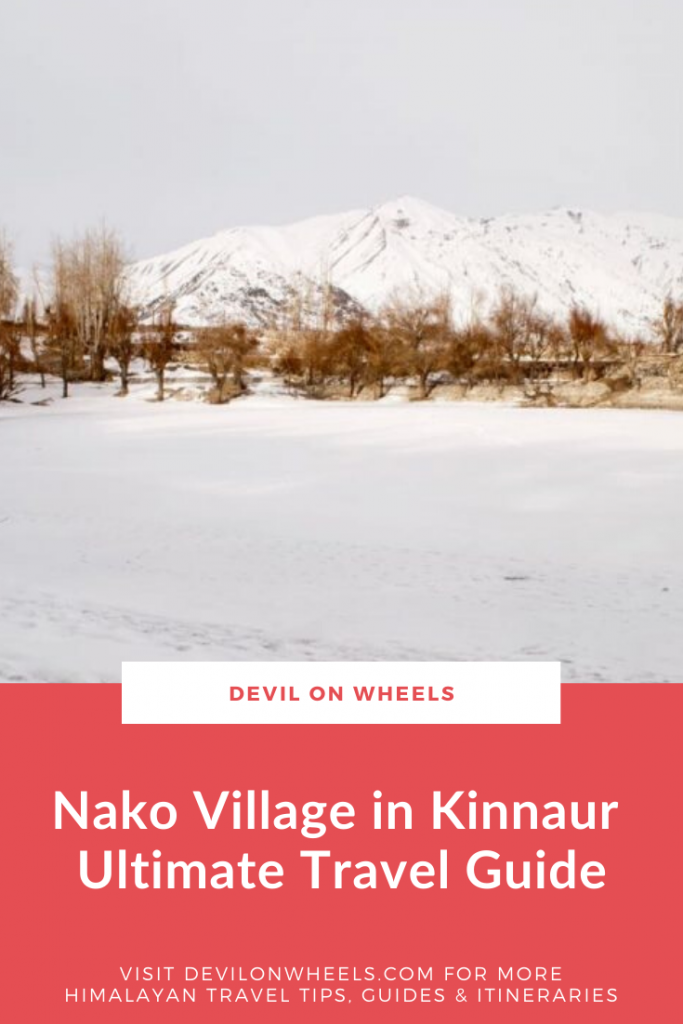
Nako Village, situated in an absolute remote corner of Himalayas, is the last major village of Kinnaur before entering the Spiti Valley. People consider it to be the largest village at the elevation of 11,893 Ft. Nako lies in the Hangrang Valley and boasts of stunning and intimidating views of the highest peak of Himachal Pradesh, Reo Purgyal (22,362 Ft).
Let's quickly dive into the details:
Nako Village Travel Guide
Often ignored for metaphorically bigger pastures, Nako Village has a lot to offer in its quiet, non-pompous manner. Given the extreme isolation from the rest of the world, Nako has a yesteryear charm, and often it feels like you’re on another galaxy in another era.
The sweet, humble, and beautiful people of the region make for great friends. And, if that wasn’t enough, the travelers you meet in this region are kindred spirits that have a yearning for exploring the world, the same way as you.
In terms of activities, Nako Lake, Nako Monastery and several Buddhist chortens all add to the lure of the region. So do yourself a favor, and do spend time in this wonderful little haven.
About Nako Village
In the corner, most of Kinnaur district lies the quaint little town of Nako. Abundantly beautiful and insanely peaceful, this is the place you wouldn’t even imagine exists. Such is the quiet nature of the village on Hindustan Tibet Highway. While most people may make a pit stop here to visit the Nako monastery – I urge you to spend more time exploring the little trails and treasures of the town.
Fun fact about the village – it moved locations to be closer to the Nako Lake from the opposite side of the river banks because the location became quite unstable due to the movement of the tectonic plates in the previous location.
In terms of the most notable features of the village, you’ll know of Nako Lake, which borders the village. Also, no mention of Nako Village will be complete without giving due credits to the Nako Monastery, dated to 1025. Nako monastery lies in the upper reaches of the village. Also, the village boasts of several other Buddhist chortens. Apple and apricots form a majority of agricultural produce from the village, thanks to the exceptional elevation of the region.
The remote location of the village is the biggest draw for the place and, of course, the limited tourist infrastructure makes it a little-visited but rewarding destination in Himachal.
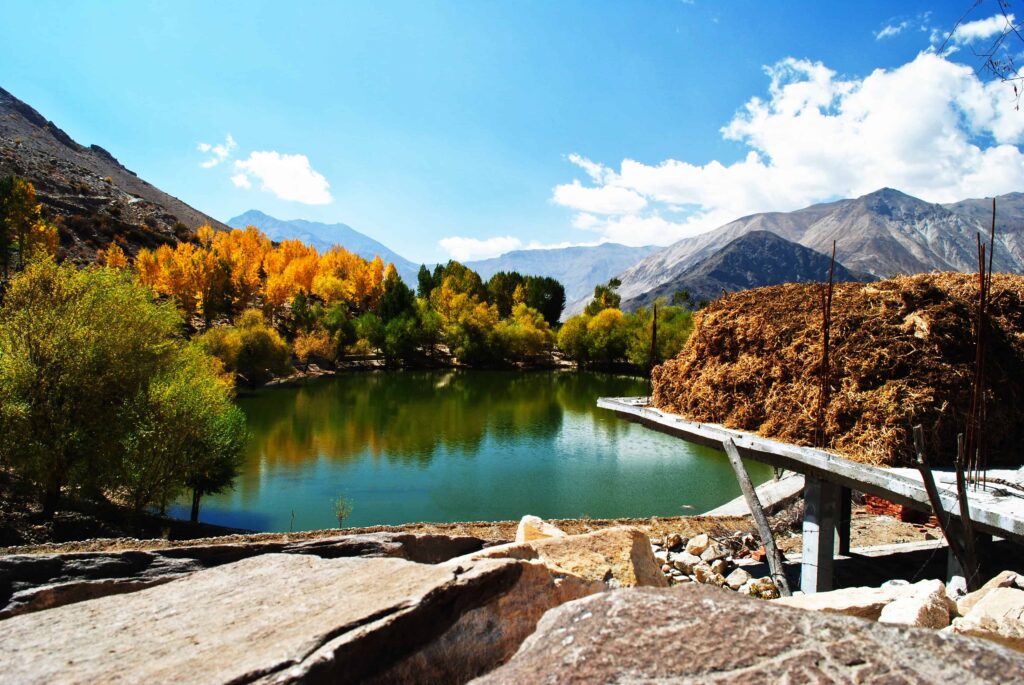
Best time to visit Nako in Kinnaur
This would depend on what you want to experience. However, Summer months make for the easiest trips with lots to do and explore. August/ September is harvest season for the apples and makes for a sight to never be forgotten, with the entire vistas turning into colors of the fertility of the land. Of course, it goes quite well with the fact that this is beautiful weather to complete the entire circuit of Shimla – Kinnaur – Spiti – Manali and back!
Nako Weather
Always cold, whether it is pleasantly chilly of the summer months, or the excruciatingly cold of the winter months, you always need to snuggle up to visit Nako. Winter months see snowfall throughout, with 5-7 feet of snow being a common phenomenon.
Summer temperatures usually average between 10-25 degrees Celsius. The end of July till the starting of September is monsoon period, and it can rain anytime, from mild showers to intense rainfall, that can even cause major landslides. The surrounding area of Nako is quite fragile and vulnerable to the landslides. Not to forget the dreaded Maling Nalla, a constant landslide zone of Hindustan – Tibet Highway.
How to reach Nako Lake?
I have discussed how to reach Kinnaur Valley extensively. To get to Nako Village – one can come in one of two ways – either through Spiti, completing the circuit, and having a stop here. The other one, the one I prefer and recommend, is traveling from the Shimla side, stopping over at Reckong Peo and exploring the Kinnaur Valley in earnest and then moving forth towards Nako and subsequently ahead.
The main reason for this suggestion is that it allows for gradual acclimatization to avoid AMS and overall better health. In terms of reaching the village, access is from a branch road of 7 km from the National Highway 22. It will take you 117 km from Kalpa to reach Nako.
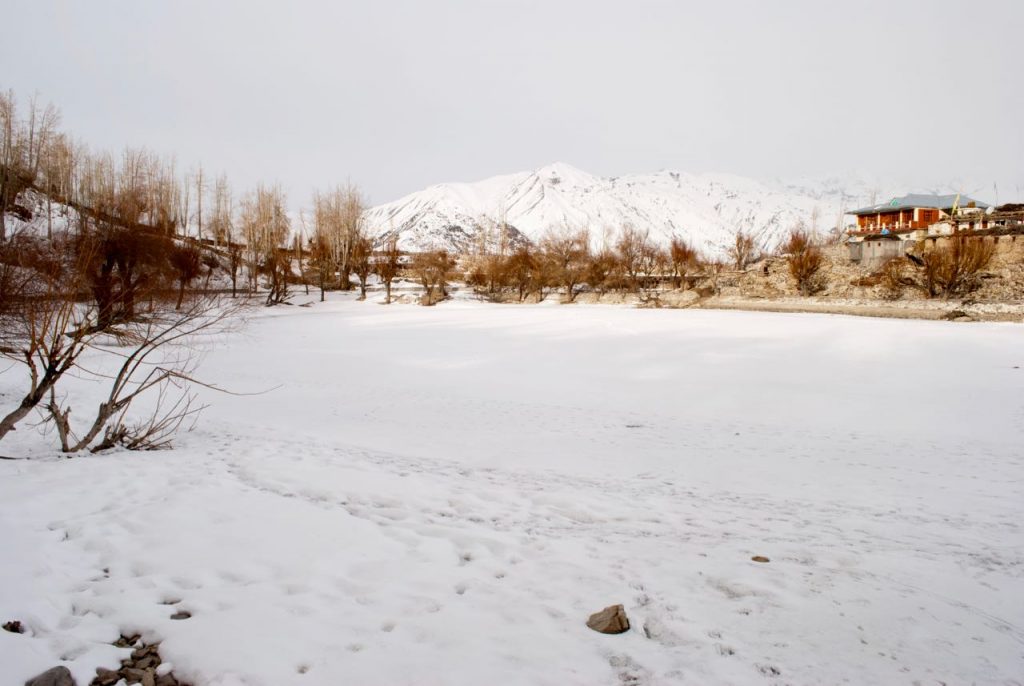
By air
The nearest airport is Shimla, which is 312 km away. From there, you’ll need to hire a cab or catch a bus towards Reckong Peo and then subsequently ahead. However, you must note that Shimla has minimal connectivity, given it’s an airport in the hills. The next best option available is Chandigarh Airport, location 425 km from Nako. Again, bus/cab options are available in the city.

By Train
Shimla is the nearest railhead. But, there is exceptionally limited connectivity at this station as well. Chandigarh airport is the closest, commercial railhead which enjoys decent connectivity
By Road – Delhi to Nako
Honestly, this is the only viable option, if you ask my opinion. Start your journey on-road and truly enjoy the mountains to the earnest. Assuming your starting point of Delhi, you have two options – described below.
Nako via Shimla – Kinnaur route
You’ll need to take the route from Chandigarh to Shimla and cross Reckong Peo to reach Nako village. This journey will take you around 14 hours from Chandigarh and 18 hours from Delhi, in terms of driving time. Goes without saying that you will need to have a stop somewhere. In my opinion – you should make your stop point on this route as Sarahan. Sarahan has a beautiful Bhimakali temple with gorgeous architecture and splendid views.
You’ll reach Tapri, where you’ll spot a petrol pump. Now, this is a fairly reliable petrol pump. The one ahead might or might not have fuel. So do remember to fill up!
The second day of your journey should then have a night halt at Sarahan/Kalpa.
The views on this drive will have you mesmerized. The higher up you go, the more unbelievable it seems, and then you reach Reckong Peo – the district’s headquarter. This place is where foreigners can get the inner line permits for moving up towards Spiti.
From Reckong Peo, after spending a few days exploring Kalpa, Sangla, Chitkul, you should be on your way to Nako. You’ll be traveling around 115 km, taking 4 hours in total. This route keeps on giving – the views, the calm, the serenity is indescribable – an experience that you need needs to feel.
If you’re looking for buses, there are a couple of buses a day that can take you to the landslide at Mulling Nullah (45 min) if you’re headed for Lahaul and Spiti, or to Reckong Peo (4-5 hours). Times can be sporadic, so enquire locally. There is also a handful of 4wd’s, some working as shared taxis (slightly costlier than a bus) and some available for private hire.
Nako to Manali via Spiti
The second option is to travel to Nako through Manali crossing the Spiti Valley region. The distance is approximately 314 km. It will take 2 days to reach Nako from Manali with an overnight stop at Kaza.
And of course, goes without saying, you will want to stop over and explore Spiti en route. You will be crossing the Jalori Pass for reaching Rampur. The route then combines with the Shimla route, taking you through to Sarahan and onwards.
Local Commute
On foot! The best way the only way to get around this tiny Nako village is to walk around it and hike around it. You will certainly enjoy camping in Nako in summer.
Nako Sightseeing
Nako village is a tiny little hamlet located deep in the upper Himalayas. As such, to an outsider, it might seem that there won’t be much to do here. However, that would be judging a book by its cover (or size, perhaps). In words of the ever intelligent, Dumbledore,
Happiness can be found in the darkest of times, if one only remembers to turn on the light.
So, look where you think nothing can be found, and nature will reveal its most beautiful treasures.
The village in itself is adorable, and the streets are gated, providing to an old-world charm that any person can hardly describe. Built from stone and wood and painted in the inside with colorful Buddhist religious paintings, these little reminders about the colorful, yet difficult, life of the villagers is such a joy to feel!
Nako Monastery
Nako Monastery was built in 1075 and is one of the places where Rinchen Zangpo, also known as Ratna Bhadra, translated Buddhist scriptures from Sanskrit to Tibetan. Also, Nako Monastery, boasting of bright, colorful artwork, faces Tibet and has a high resemblance to the Tabo Monastery architecturally consisting of four large halls of which the oldest and largest is known as Dukhong.
To honor Rinchen Zangpo, the monastery is also sometimes called ‘Lotsava Jhakang’, i.e. “complex of the translator”. Rinchen translated Buddhist scriptures from Sanskrit to the Tibetan language and is thus highly revered in the Buddhist culture.
The artwork in the monastery is gorgeous and related to Vajrayana Buddhism. At the same time, Dukhong’s walls are decorated to depict gates, fire-circle, and secondary non-Buddhist deities in attendance.
Other halls in the complex include sculptures representing Yellow Tara, Sculptures of five Dhyani Buddhas made out of clay, and a shrine dedicated to Purgyal, also known as the spirit of the mountains.
Trip Suggestion: You can combine a trip to Chitkul with Nako on any of your trip to Kinnaur Valley.
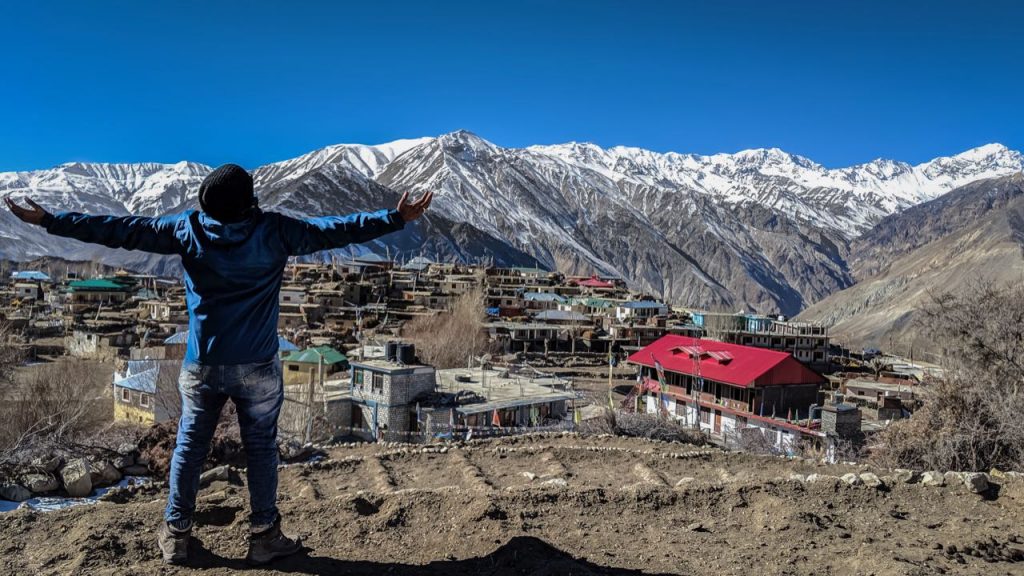
An Interesting Fact
An interesting fact to note about the monastery is that in 1975, due to an earthquake, the monastery was effected, and certain vandals stole important art from this place. The buildings and structures were also severely impacted. With such a terrible condition and subsequent freezing winter seasons, the monastery was near collapse.
However, the University of Vienna launched a research project in association with the Indian National Trust for Art and Cultural Heritage (INTACH), the Buddhist Association of Nako, and residents of Nako to carry out restoration works. Thanks to the amazing hard work of the team and pure dedication from the villagers, In July 2002, the Nako Preservation Project (NPP) came to be established for the conservation of the monastery and other buildings in Nako.
Nako Lake
While Nako Lake is a small lake in comparison to some of its famous peers, it is an integral part of the village and culture. Nako lake height is 11929 feet, and it lies on the slopes of the Reo Purgyal mountain range. In the evening hours, the lake is a sight to behold and provides for a very calming natural experience.
Lots of birds flock to the lake every evening and fill the atmosphere with melancholic songs. The periphery of the lake has plantations of willow and poplar trees. These natural elements make for a major attraction for tourists to stopover. So, naturally, the villagers have made a livelihood from it. The lake has boating facilities during the summer months, and locals play ice skating on the lake’s surface which gets frozen during the winter months.
Trip Suggestion: You can combine a trip to Sangla Valley with Nako on any of your trip to Kinnaur Valley.
Padmasambhava Temple
Mythological stories dictate that a rock which lies somewhere near the Nako Lake and locals believe that there is a footprint of Padmasambhava. A shrine has been built around this footprint to commemorate it. There is also a statue of Padmasambhava above it.
Chango Gompa
Chango Gompa lies about 25 km away from the Nako monastery on the road to Spiti in the Chango village. The Gompa has a prayer wheel that is over 500 years old and measures about 11 ft. in diameter. It is made up of yak skin.

Trails around Nako Village
There are easy trails around the village which are mostly used by the shepherd to traverse to different surrounding villages, including, Chango, Hango and Tashigang village. These nice day walks are a wonderful way to explore the surrounding mountains.
For example, just behind the lake, if you climb upwards to the visible chortens, you’ll have the most beautiful vantage point. You may keep climbing to the other side of the mountain, which might take you around 3-4 hours, and you’ll see the entire Sutlej Valley from the village of Tashigang. Here, an interesting and inviting temple will welcome you. The only things you’ll encounter underway are sheepherders and stunning vistas.
Where to stay in Nako Village
While the village is tiny, there are three options – all at the beginning of the village – where tourists may stay. Although the popularity of the village comes because it is en route Spiti from Kinnaur, I am hopeful tourism will pick up here and some homestays, etc. will open up in the future.
Amar Homestay is one of the only few places where you may crash. The family is super nice and lovely and will provide you with all the comfort. Galaxy Guesthouse is the best budget option with rooms providing stunning views. Lavon guesthouse is another option with similar standards and a similar price range of around INR 150-700.
Reo Purgil and Knaygoh Kinner Camp are the two hotel and camping options at Nako Village. The hotel Reo Purgil doesn’t quite go with the surroundings and is a standard affair hotel.
However, it is best suited to those that need certain western amenities. Alcohol is available at the hotel. The Knaygoh Kinner Camp is amazing and has a total of 11 quality camps with attached bathrooms along with guest house rooms. A restaurant on the premises serves decent, comforting food!
You may check our article on good places to stay in Kinnaur & Spiti Valley.
Where to eat
A few local dhabas serve very basic local food such as momos, Chowmein, or rice & dal. When you’re in the region, you MUST try the salted Tibetan butter tea.
Reo Purgil has a little more variety and caters more to foreign tastes.
You should always carry your water bottle and refill it as many times as you need water. It will not only keep you hydrated always, but you will also help in saving the Himalayas from plastic garbage. Remember, every tiny step counts and your step in this direction can help save the Himalayas too !! 🙂 🙂
Keep in Mind – Other Tips
- Always walk clockwise around temples and chortens, and keep your right side facing them. Don’t touch them with your left hand.
- Nako doesn’t see much tourist traffic, so tread lightly and be discreet and polite.
- You’re at exceptional height. Even if the weather is pleasant, do remember the sun rays will hit you hard. So hydrate, use sunscreen and take it easy. Also, wear layers of clothing to make it easy to be comfortable at all times.
- Solar panels are installed for most places. The village Pradhan strongly believes in keeping the environment clean.
- Photography is strictly prohibited in the monastery.
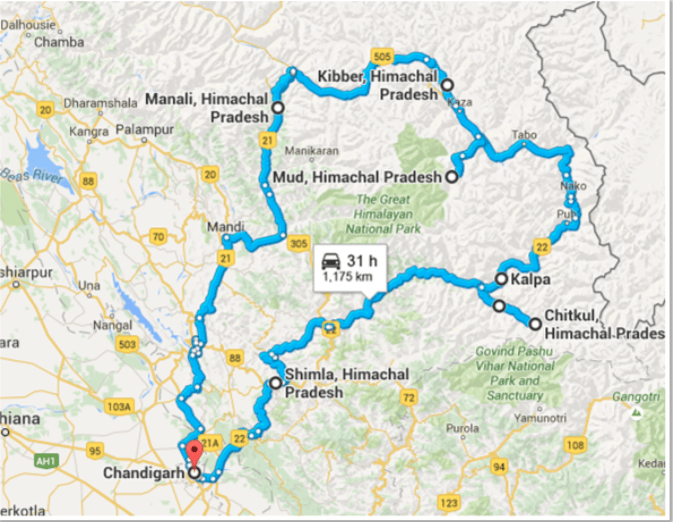
FAQs of Nako Trip
While we are happy and eager to answer your individual questions regarding any travel plans you might have, I am covering a few common questions to help ease your queries.
Is an Inner Line Permit required to visit Nako?
Yes, Foreign nationals will require a permit to visit Nako. An Inner Line Permit is available in Reckong Peo for Rs.400 or Kaza or Shimla for Rs.300 and is good for 14 days. Overnight stay is not allowed anywhere within the restricted zone unless you have the Inner Line Permit.
Is AMS a concern?
You’re at 3600 meters. Yes, it might become a concern and the lack of oxygen can become apparent. Be careful and aware of the signals your body is giving you and acclimatize before you reach. Nako is notoriously known to cause AMS issues. Do not forget to check our article on acclimatization and tips to avoid AMS.
Is electricity available?
Yes, electricity is available in Nako. However, electricity is very intermittent, and power cuts are frequent. This lack of electricity is not much of a concern as the weather ranges from pleasant to frigid cold throughout the year. But, it might become a concern if you need to charge your gadgets, etc.
Can one get internet/mobile phone connectivity?
Difficult and unlikely. Locals say you get BSNL postpaid phone connectivity at 1 AM at night. This theory has not been tested by me, however. Some places you might get lucky and get some bars on your phone – but, the chances are slim. It is a remote village, after all.
What are the medical facilities that are available?
Close to none. There is a Medical Treatment Center near the Gompa, however, it doesn’t.
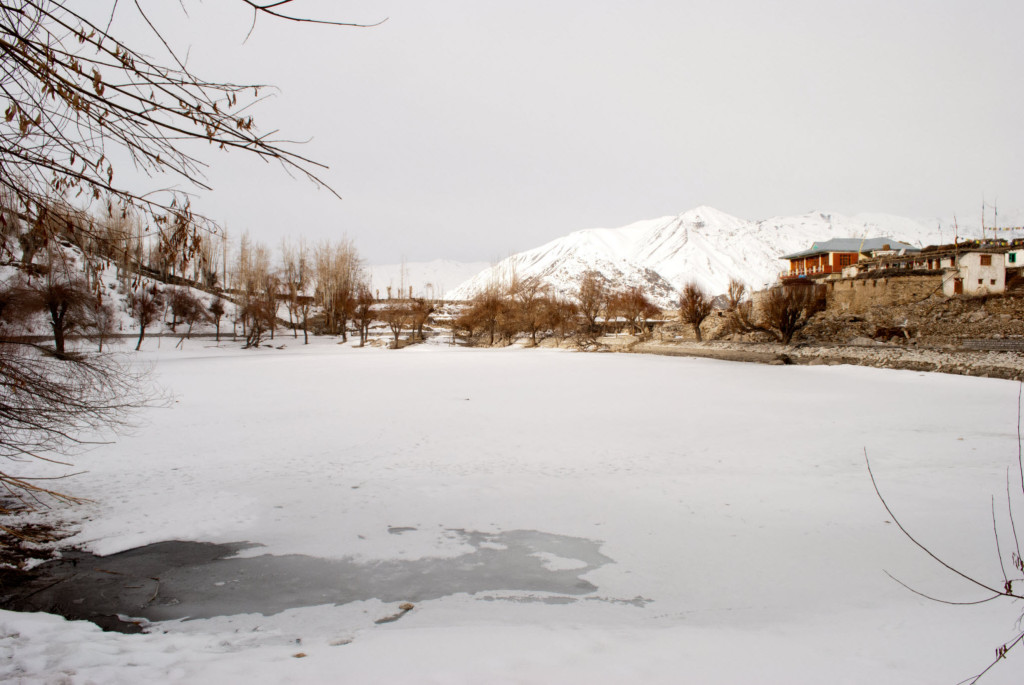
Conclusion
On the quest to Spiti, not a lot of people stop over at Nako! And, oh, what a terrible fate – this is a village that deserves your attention, for she has many stories to tell.
Have a travel question?? You can subscribe to my YouTube channel and leave a comment to ask your travel questions on traveling to the Himalayas.
I hope this article helps you plan a memorable trip to Nako and nearby villages of Kinnaur or Spiti Valley. If any of your friends are planning to travel to Nako or upper Kinnaur Valley, please feel free to share this Nako travel guide with them.




![What are tips for long-distance bike ride in Ladakh or Spiti? [10 Practical Tips]](https://discoverwithdheeraj.com/yt_vid_thumbs/ladakh/86.png)

1 Comment
Comments section gets closed in 90 days. To ask your travel questions, you can follow my YouTube Channel for a faster reply or for a much slower reply follow me on Instagram. :)
Thanks for this wonderful article